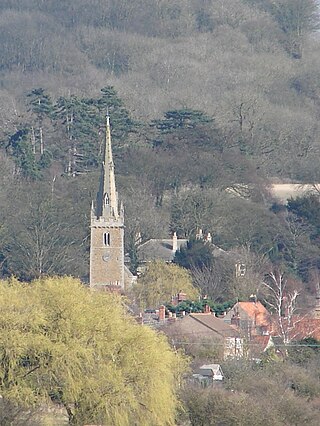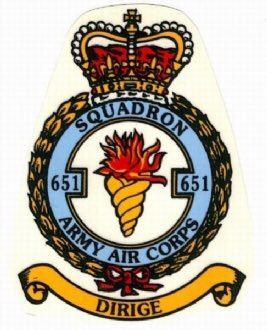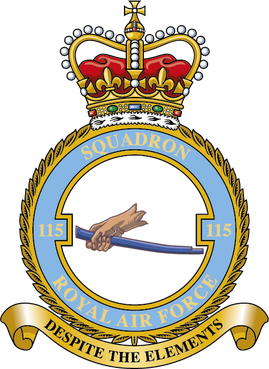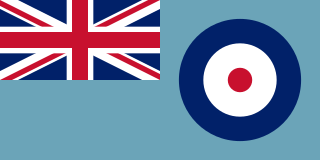
The Army Air Corps (AAC) is the aviation arm of the British Army, first formed in 1942 during the Second World War by grouping the various airborne units of the British Army. Today, there are eight regiments of the AAC, as well as two independent flights and two independent squadrons deployed in support of British Army operations around the world. Regiments and flights are located in the United Kingdom, Kenya, and Canada. Some AAC squadrons provide the air assault elements of 16 Air Assault Brigade Combat Team, through Joint Aviation Command.

Aldergrove Flying Station, also known previously as JHC FS Aldergrove, is a British military base located 4.4 miles (7.1 km) south of Antrim, Northern Ireland and 18 miles (29 km) northwest of Belfast, and adjoins Belfast International Airport. It is sometimes referred to simply as Aldergrove which is the name of a nearby hamlet.

Royal Air Force Cranwell or more simply RAF Cranwell is a Royal Air Force station in Lincolnshire, England, close to the village of Cranwell, near Sleaford. Among other functions, it is home to the Royal Air Force College (RAFC), which trains the RAF's new officers and aircrew. The motto, Altium Altrix, meaning "Nurture the highest" appears above the main doors of the Officers Mess. Since January 2023, RAF Cranwell has been commanded by Group Captain Tina Jessup.

Royal Air Force Barkston Heath or RAF Barkston Heath is a Royal Air Force Relief Landing Ground under the command of RAF Cranwell near Grantham, Lincolnshire, England.

Royal Air Force Shawbury, otherwise known as RAF Shawbury, is a Royal Air Force station near the village of Shawbury in Shropshire in the West Midlands of England.

Barkston is an English village and civil parish in the South Kesteven district of Lincolnshire. The parish population was 497 at the 2001 census and 493 at the 2011 census. The village lies about 4 miles (6 km) north of the market town of Grantham, on the A607, just south of the junction with the A153 to Ancaster.

No. 22 Group Royal Air Force is one of six groups currently active in the Royal Air Force (RAF), falling under the responsibility of Deputy Commander-in-Chief (Personnel) in Air Command. Its previous title up until 2018 was No. 22 (Training) Group. The group is responsible for RAF training policy and controlling the Royal Air Force College and the RAF's training stations. As such, it is the direct successor to Training Group. 22 Group provides training to all three service branches of the British Armed Forces; namely the Royal Air Force, the Royal Navy, and the British Army.

No. 651 Squadron Army Air Corps, is an aircraft squadron of the British Army, originally formed as No. 651 Squadron Royal Air Force in Italy and North Africa during the Second World War, and afterwards in Egypt. Numbers 651 to 663 Squadrons of the RAF were air observation post units which had both Army and RAF personnel. The pilots, drivers and signallers were in the Royal Artillery whilst the adjutants, technical staff and equipment officers came from the RAF. Air observation posts were used primarily for artillery spotting, but occasionally for liaison and other duties. Their duties and squadron numbers were transferred to the Army with the formation of the Army Air Corps on 1 September 1957.

Netheravon Airfield is a Ministry of Defence grass strip airfield on Salisbury Plain, in Wiltshire, England. Established in 1913 by the Royal Flying Corps, it became RAF Netheravon from 1918 until 1963, then AAC Netheravon until 2012. Buildings from 1913 and 1914 survive on part of the site. The site forms part of the Tidworth, Netheravon and Bulford (TidNBul) Garrison.

Number 115 Squadron is a Royal Air Force squadron operating the Grob Tutor T1, training QFIs for the RAF's Elementary Flying Training (EFT) squadrons and the University Air Squadrons, as well as undertaking evaluation and standardisation duties.

703 Naval Air Squadron is a Fleet Air Arm (FAA) naval air squadron of the United Kingdom’s Royal Navy (RN). It was formed as a long-range catapult squadron on 3 March 1942 at RNAS Lee-on-Solent. During the Cold War, it was reformed as an experimental trials unit, and then as a helicopter training squadron. Since 2003, the squadron has formed the Royal Naval wing of the Defence Elementary Flying Training School at RAF Barkston Heath.
6 Regiment Army Air Corps is the sole Army Reserve regiment of the British Army Air Corps (AAC). The regiment consists of four Squadrons based around the south of the UK. 6 Regiment provides soldiers trained to assist Joint Aviation Command on exercise and operations both in the UK and worldwide. The regiment provides support to support and attack helicopter in roles including Aviation Groundcrew Specialists, Aviation Communication Operators and Aviation Support Officers.

3 RegimentArmy Air Corps is a regiment of the British Army and is under the command of the 1st Aviation Brigade Combat Team within Joint Aviation Command (JAC). The regiment operates the Boeing AH-64E Apache attack helicopter, and is based out of Wattisham Flying Station.
No. 660 Squadron AAC is a squadron of the British Army's Army Air Corps (AAC). It was formerly No. 660 Squadron RAF, a Royal Air Force air observation post squadron associated with the 21st Army Group during the Second World War. Numbers 651 to 663 Squadrons of the RAF were air observation post units working closely with British Army units in artillery spotting and liaison. A further three of these squadrons, 664–666, were manned with Canadian personnel. Their duties and squadron numbers were transferred to the Army with the formation of the Army Air Corps on 1 September 1957.
5 Regiment Army Air Corps is a regiment of the British Army and is part of the Joint Aviation Command (JAC). The regiment was formerly based in Northern Ireland at Aldergrove Flying Station, but is now based at Middle Wallop Flying Station.

The UK Military Flying Training System (UKMFTS) takes UK armed forces aircrew from initial training through elementary, basic, and advanced flying training phases, preparing them for their arrival at their designated operational aircraft units. It is operated by Ascent Flight Training, a consortium of Lockheed Martin and Babcock International under a 25-year Private Finance Initiative (PFI) contract for the UK's Ministry of Defence (MoD), with oversight from the MoD. The airworthiness authority for each aircraft type, for example, is fulfilled by military and civilian staff within Defence Equipment and Support. Apart from the overall contract, the main elements of the system include fixed-wing elementary, multi-engine and fast-jet pilot training, rear crew training and rotary-wing (helicopter) training.

No. 3 Flying Training School is a Royal Air Force military training school, which manages elementary flying training for the Royal Navy and Royal Air Force and also for the training of all non-pilot aircrew for the RAF and is home to the Central Flying School Tutor Squadron.
No. 652 Squadron AAC is a squadron of the British Army's Army Air Corps (AAC). It was previously No. 652 Squadron RAF, a unit of the Royal Air Force during the Second World War and afterwards in Germany.

This is the structure of the Royal Air Force.















